Research on Organic Food Practices in China: A Consumer Viewpoint
VerifiedAdded on 2023/01/18
|24
|6860
|89
Project
AI Summary
This project, titled 'Identifying organic food practices in the agricultural sector in china: a consumer perspective,' investigates the growing demand for organic food in China due to concerns about food safety and environmental issues. It examines the challenges in the organic food industry, including lack of transparency and mislabeling. The research aims to understand consumer behavior, eating habits, and awareness of organic standards. The study reviews literature on organic food and its significance, production, and consumption practices in China. The methodology involves both primary and secondary data collection, including surveys and thematic literature reviews. The project discusses the significance of the study, potential benefits for consumers, and future research directions. The research is structured into five chapters: introduction, literature review, methodology, results and analysis, and conclusion, providing a comprehensive overview of the organic food landscape in China.
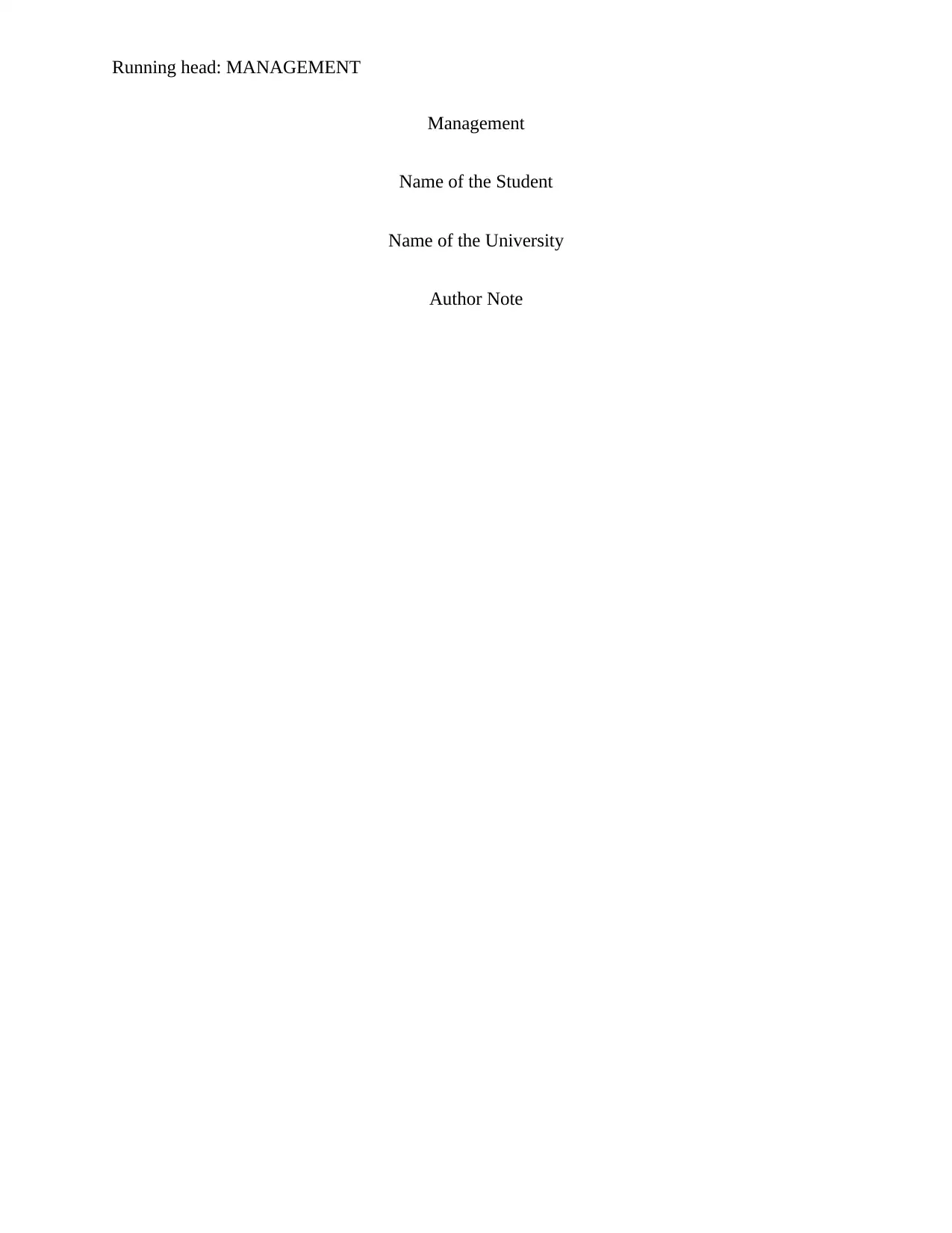
Running head: MANAGEMENT
Management
Name of the Student
Name of the University
Author Note
Management
Name of the Student
Name of the University
Author Note
Paraphrase This Document
Need a fresh take? Get an instant paraphrase of this document with our AI Paraphraser
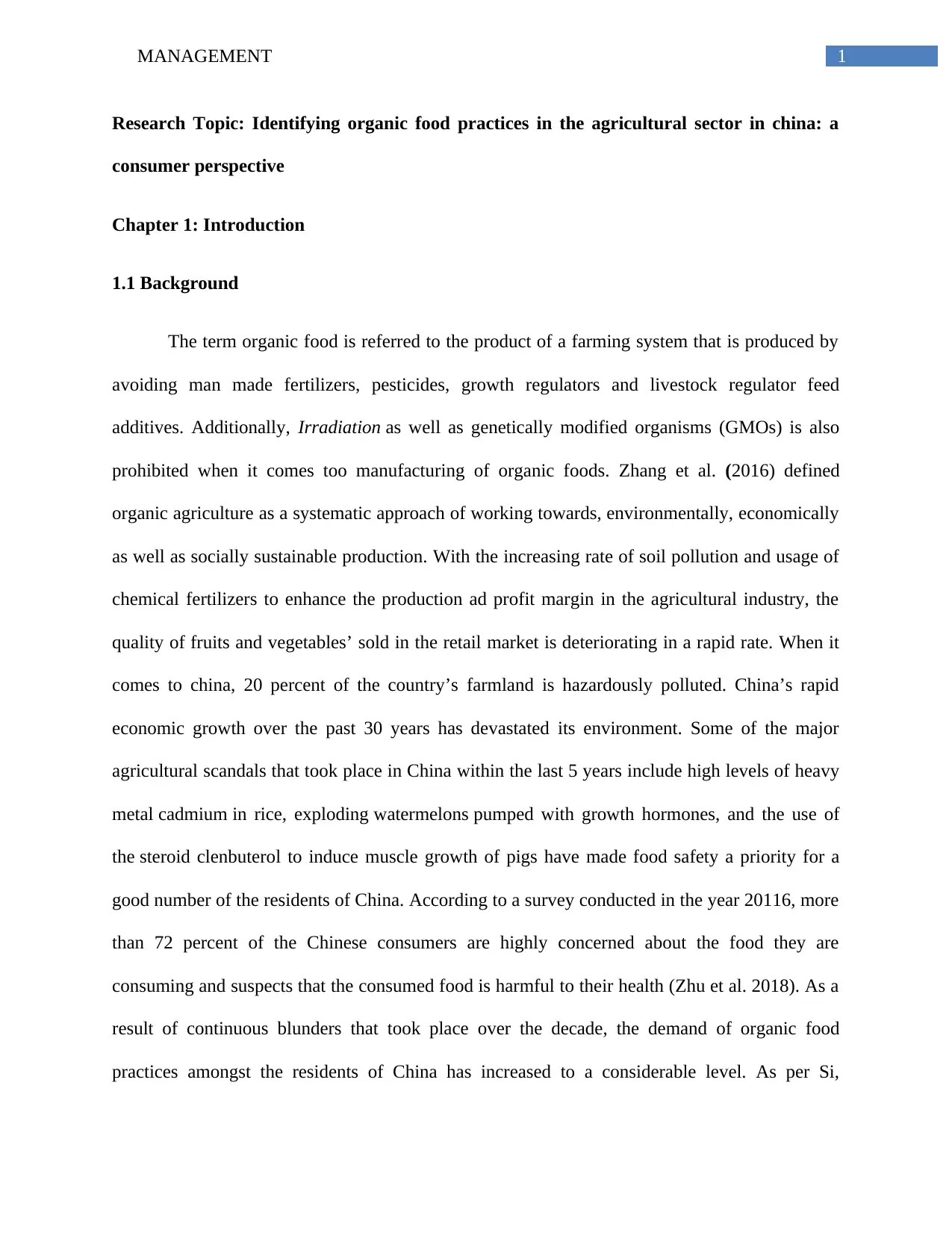
1MANAGEMENT
Research Topic: Identifying organic food practices in the agricultural sector in china: a
consumer perspective
Chapter 1: Introduction
1.1 Background
The term organic food is referred to the product of a farming system that is produced by
avoiding man made fertilizers, pesticides, growth regulators and livestock regulator feed
additives. Additionally, Irradiation as well as genetically modified organisms (GMOs) is also
prohibited when it comes too manufacturing of organic foods. Zhang et al. (2016) defined
organic agriculture as a systematic approach of working towards, environmentally, economically
as well as socially sustainable production. With the increasing rate of soil pollution and usage of
chemical fertilizers to enhance the production ad profit margin in the agricultural industry, the
quality of fruits and vegetables’ sold in the retail market is deteriorating in a rapid rate. When it
comes to china, 20 percent of the country’s farmland is hazardously polluted. China’s rapid
economic growth over the past 30 years has devastated its environment. Some of the major
agricultural scandals that took place in China within the last 5 years include high levels of heavy
metal cadmium in rice, exploding watermelons pumped with growth hormones, and the use of
the steroid clenbuterol to induce muscle growth of pigs have made food safety a priority for a
good number of the residents of China. According to a survey conducted in the year 20116, more
than 72 percent of the Chinese consumers are highly concerned about the food they are
consuming and suspects that the consumed food is harmful to their health (Zhu et al. 2018). As a
result of continuous blunders that took place over the decade, the demand of organic food
practices amongst the residents of China has increased to a considerable level. As per Si,
Research Topic: Identifying organic food practices in the agricultural sector in china: a
consumer perspective
Chapter 1: Introduction
1.1 Background
The term organic food is referred to the product of a farming system that is produced by
avoiding man made fertilizers, pesticides, growth regulators and livestock regulator feed
additives. Additionally, Irradiation as well as genetically modified organisms (GMOs) is also
prohibited when it comes too manufacturing of organic foods. Zhang et al. (2016) defined
organic agriculture as a systematic approach of working towards, environmentally, economically
as well as socially sustainable production. With the increasing rate of soil pollution and usage of
chemical fertilizers to enhance the production ad profit margin in the agricultural industry, the
quality of fruits and vegetables’ sold in the retail market is deteriorating in a rapid rate. When it
comes to china, 20 percent of the country’s farmland is hazardously polluted. China’s rapid
economic growth over the past 30 years has devastated its environment. Some of the major
agricultural scandals that took place in China within the last 5 years include high levels of heavy
metal cadmium in rice, exploding watermelons pumped with growth hormones, and the use of
the steroid clenbuterol to induce muscle growth of pigs have made food safety a priority for a
good number of the residents of China. According to a survey conducted in the year 20116, more
than 72 percent of the Chinese consumers are highly concerned about the food they are
consuming and suspects that the consumed food is harmful to their health (Zhu et al. 2018). As a
result of continuous blunders that took place over the decade, the demand of organic food
practices amongst the residents of China has increased to a considerable level. As per Si,
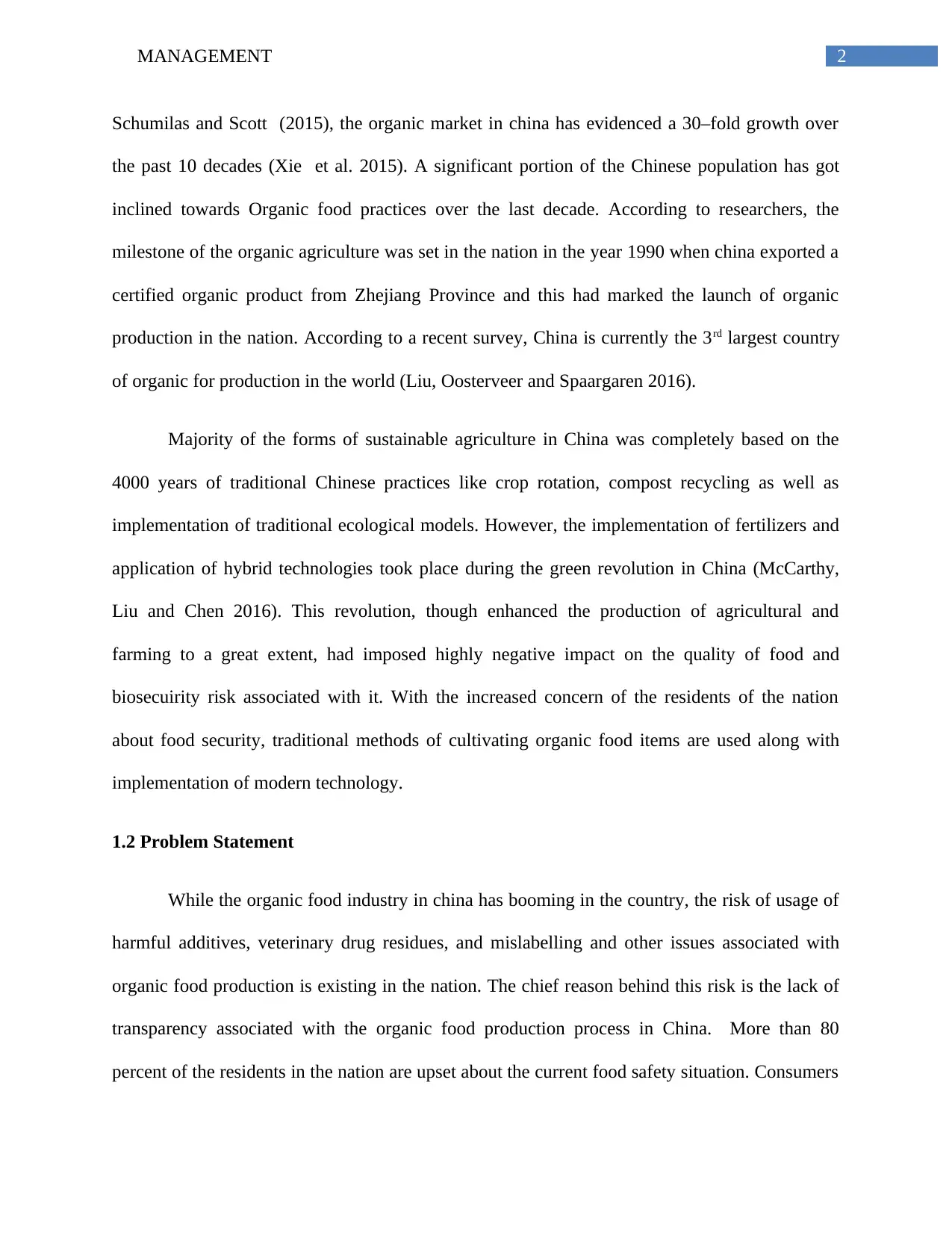
2MANAGEMENT
Schumilas and Scott (2015), the organic market in china has evidenced a 30–fold growth over
the past 10 decades (Xie et al. 2015). A significant portion of the Chinese population has got
inclined towards Organic food practices over the last decade. According to researchers, the
milestone of the organic agriculture was set in the nation in the year 1990 when china exported a
certified organic product from Zhejiang Province and this had marked the launch of organic
production in the nation. According to a recent survey, China is currently the 3rd largest country
of organic for production in the world (Liu, Oosterveer and Spaargaren 2016).
Majority of the forms of sustainable agriculture in China was completely based on the
4000 years of traditional Chinese practices like crop rotation, compost recycling as well as
implementation of traditional ecological models. However, the implementation of fertilizers and
application of hybrid technologies took place during the green revolution in China (McCarthy,
Liu and Chen 2016). This revolution, though enhanced the production of agricultural and
farming to a great extent, had imposed highly negative impact on the quality of food and
biosecuirity risk associated with it. With the increased concern of the residents of the nation
about food security, traditional methods of cultivating organic food items are used along with
implementation of modern technology.
1.2 Problem Statement
While the organic food industry in china has booming in the country, the risk of usage of
harmful additives, veterinary drug residues, and mislabelling and other issues associated with
organic food production is existing in the nation. The chief reason behind this risk is the lack of
transparency associated with the organic food production process in China. More than 80
percent of the residents in the nation are upset about the current food safety situation. Consumers
Schumilas and Scott (2015), the organic market in china has evidenced a 30–fold growth over
the past 10 decades (Xie et al. 2015). A significant portion of the Chinese population has got
inclined towards Organic food practices over the last decade. According to researchers, the
milestone of the organic agriculture was set in the nation in the year 1990 when china exported a
certified organic product from Zhejiang Province and this had marked the launch of organic
production in the nation. According to a recent survey, China is currently the 3rd largest country
of organic for production in the world (Liu, Oosterveer and Spaargaren 2016).
Majority of the forms of sustainable agriculture in China was completely based on the
4000 years of traditional Chinese practices like crop rotation, compost recycling as well as
implementation of traditional ecological models. However, the implementation of fertilizers and
application of hybrid technologies took place during the green revolution in China (McCarthy,
Liu and Chen 2016). This revolution, though enhanced the production of agricultural and
farming to a great extent, had imposed highly negative impact on the quality of food and
biosecuirity risk associated with it. With the increased concern of the residents of the nation
about food security, traditional methods of cultivating organic food items are used along with
implementation of modern technology.
1.2 Problem Statement
While the organic food industry in china has booming in the country, the risk of usage of
harmful additives, veterinary drug residues, and mislabelling and other issues associated with
organic food production is existing in the nation. The chief reason behind this risk is the lack of
transparency associated with the organic food production process in China. More than 80
percent of the residents in the nation are upset about the current food safety situation. Consumers
⊘ This is a preview!⊘
Do you want full access?
Subscribe today to unlock all pages.

Trusted by 1+ million students worldwide
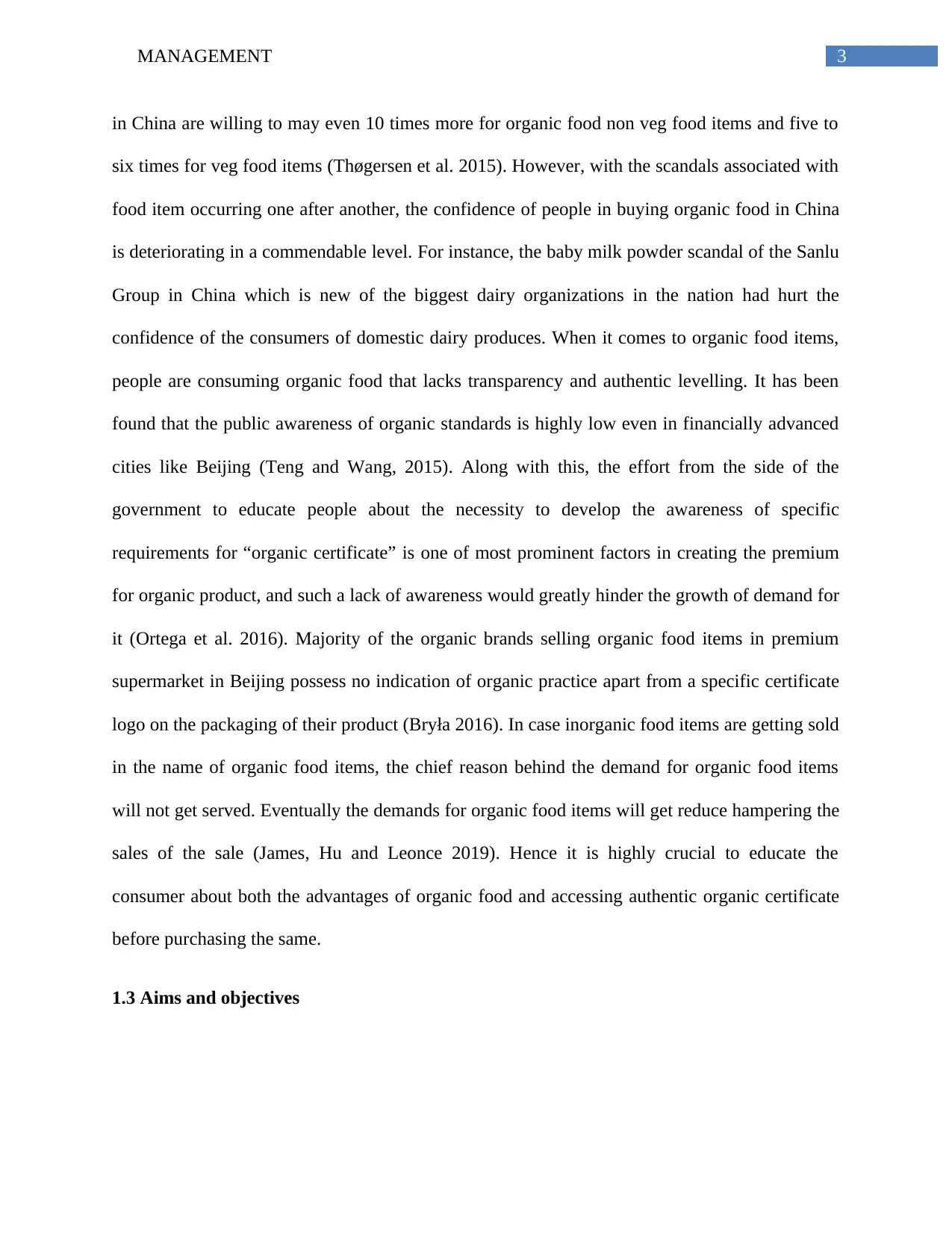
3MANAGEMENT
in China are willing to may even 10 times more for organic food non veg food items and five to
six times for veg food items (Thøgersen et al. 2015). However, with the scandals associated with
food item occurring one after another, the confidence of people in buying organic food in China
is deteriorating in a commendable level. For instance, the baby milk powder scandal of the Sanlu
Group in China which is new of the biggest dairy organizations in the nation had hurt the
confidence of the consumers of domestic dairy produces. When it comes to organic food items,
people are consuming organic food that lacks transparency and authentic levelling. It has been
found that the public awareness of organic standards is highly low even in financially advanced
cities like Beijing (Teng and Wang, 2015). Along with this, the effort from the side of the
government to educate people about the necessity to develop the awareness of specific
requirements for “organic certificate” is one of most prominent factors in creating the premium
for organic product, and such a lack of awareness would greatly hinder the growth of demand for
it (Ortega et al. 2016). Majority of the organic brands selling organic food items in premium
supermarket in Beijing possess no indication of organic practice apart from a specific certificate
logo on the packaging of their product (Bryła 2016). In case inorganic food items are getting sold
in the name of organic food items, the chief reason behind the demand for organic food items
will not get served. Eventually the demands for organic food items will get reduce hampering the
sales of the sale (James, Hu and Leonce 2019). Hence it is highly crucial to educate the
consumer about both the advantages of organic food and accessing authentic organic certificate
before purchasing the same.
1.3 Aims and objectives
in China are willing to may even 10 times more for organic food non veg food items and five to
six times for veg food items (Thøgersen et al. 2015). However, with the scandals associated with
food item occurring one after another, the confidence of people in buying organic food in China
is deteriorating in a commendable level. For instance, the baby milk powder scandal of the Sanlu
Group in China which is new of the biggest dairy organizations in the nation had hurt the
confidence of the consumers of domestic dairy produces. When it comes to organic food items,
people are consuming organic food that lacks transparency and authentic levelling. It has been
found that the public awareness of organic standards is highly low even in financially advanced
cities like Beijing (Teng and Wang, 2015). Along with this, the effort from the side of the
government to educate people about the necessity to develop the awareness of specific
requirements for “organic certificate” is one of most prominent factors in creating the premium
for organic product, and such a lack of awareness would greatly hinder the growth of demand for
it (Ortega et al. 2016). Majority of the organic brands selling organic food items in premium
supermarket in Beijing possess no indication of organic practice apart from a specific certificate
logo on the packaging of their product (Bryła 2016). In case inorganic food items are getting sold
in the name of organic food items, the chief reason behind the demand for organic food items
will not get served. Eventually the demands for organic food items will get reduce hampering the
sales of the sale (James, Hu and Leonce 2019). Hence it is highly crucial to educate the
consumer about both the advantages of organic food and accessing authentic organic certificate
before purchasing the same.
1.3 Aims and objectives
Paraphrase This Document
Need a fresh take? Get an instant paraphrase of this document with our AI Paraphraser
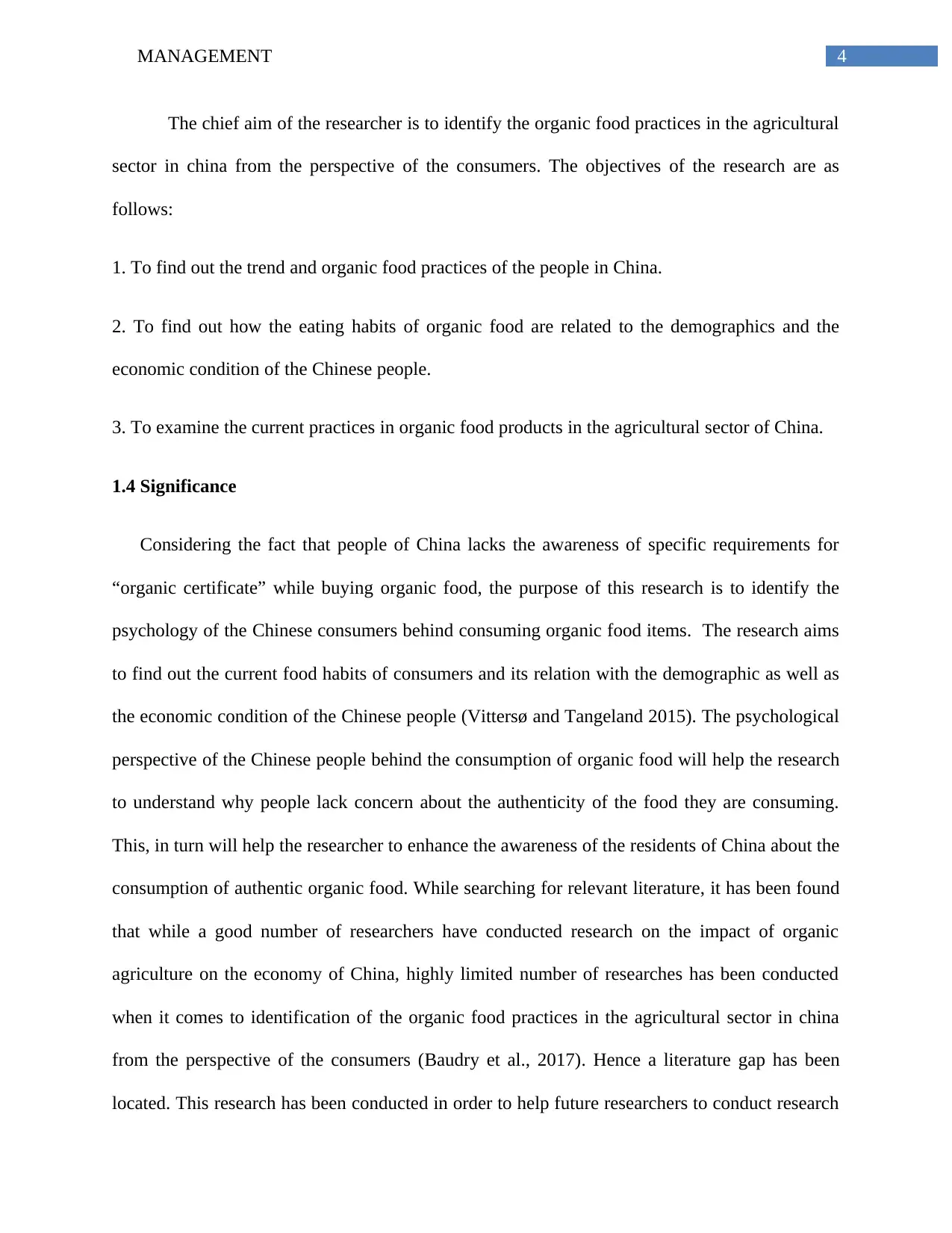
4MANAGEMENT
The chief aim of the researcher is to identify the organic food practices in the agricultural
sector in china from the perspective of the consumers. The objectives of the research are as
follows:
1. To find out the trend and organic food practices of the people in China.
2. To find out how the eating habits of organic food are related to the demographics and the
economic condition of the Chinese people.
3. To examine the current practices in organic food products in the agricultural sector of China.
1.4 Significance
Considering the fact that people of China lacks the awareness of specific requirements for
“organic certificate” while buying organic food, the purpose of this research is to identify the
psychology of the Chinese consumers behind consuming organic food items. The research aims
to find out the current food habits of consumers and its relation with the demographic as well as
the economic condition of the Chinese people (Vittersø and Tangeland 2015). The psychological
perspective of the Chinese people behind the consumption of organic food will help the research
to understand why people lack concern about the authenticity of the food they are consuming.
This, in turn will help the researcher to enhance the awareness of the residents of China about the
consumption of authentic organic food. While searching for relevant literature, it has been found
that while a good number of researchers have conducted research on the impact of organic
agriculture on the economy of China, highly limited number of researches has been conducted
when it comes to identification of the organic food practices in the agricultural sector in china
from the perspective of the consumers (Baudry et al., 2017). Hence a literature gap has been
located. This research has been conducted in order to help future researchers to conduct research
The chief aim of the researcher is to identify the organic food practices in the agricultural
sector in china from the perspective of the consumers. The objectives of the research are as
follows:
1. To find out the trend and organic food practices of the people in China.
2. To find out how the eating habits of organic food are related to the demographics and the
economic condition of the Chinese people.
3. To examine the current practices in organic food products in the agricultural sector of China.
1.4 Significance
Considering the fact that people of China lacks the awareness of specific requirements for
“organic certificate” while buying organic food, the purpose of this research is to identify the
psychology of the Chinese consumers behind consuming organic food items. The research aims
to find out the current food habits of consumers and its relation with the demographic as well as
the economic condition of the Chinese people (Vittersø and Tangeland 2015). The psychological
perspective of the Chinese people behind the consumption of organic food will help the research
to understand why people lack concern about the authenticity of the food they are consuming.
This, in turn will help the researcher to enhance the awareness of the residents of China about the
consumption of authentic organic food. While searching for relevant literature, it has been found
that while a good number of researchers have conducted research on the impact of organic
agriculture on the economy of China, highly limited number of researches has been conducted
when it comes to identification of the organic food practices in the agricultural sector in china
from the perspective of the consumers (Baudry et al., 2017). Hence a literature gap has been
located. This research has been conducted in order to help future researchers to conduct research
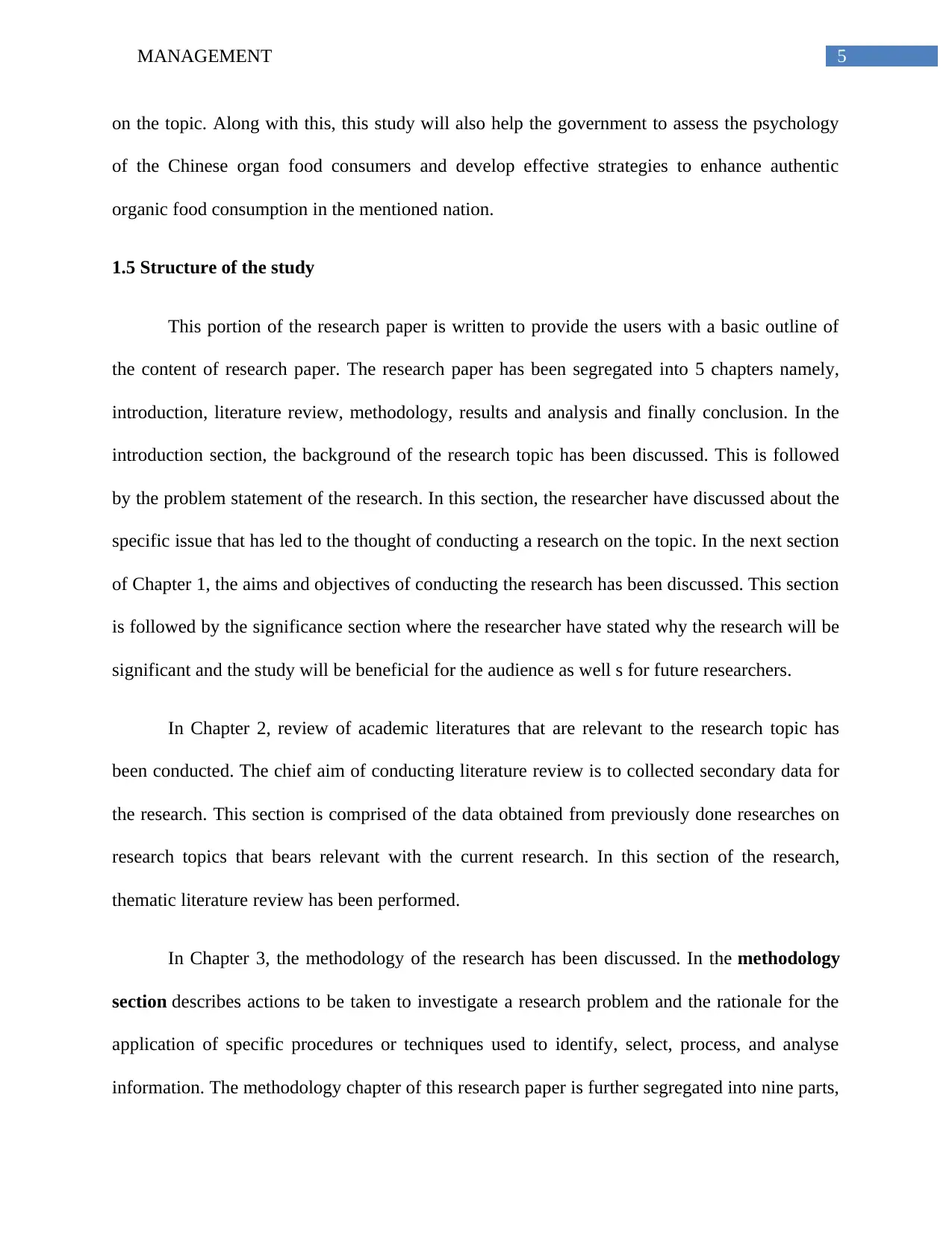
5MANAGEMENT
on the topic. Along with this, this study will also help the government to assess the psychology
of the Chinese organ food consumers and develop effective strategies to enhance authentic
organic food consumption in the mentioned nation.
1.5 Structure of the study
This portion of the research paper is written to provide the users with a basic outline of
the content of research paper. The research paper has been segregated into 5 chapters namely,
introduction, literature review, methodology, results and analysis and finally conclusion. In the
introduction section, the background of the research topic has been discussed. This is followed
by the problem statement of the research. In this section, the researcher have discussed about the
specific issue that has led to the thought of conducting a research on the topic. In the next section
of Chapter 1, the aims and objectives of conducting the research has been discussed. This section
is followed by the significance section where the researcher have stated why the research will be
significant and the study will be beneficial for the audience as well s for future researchers.
In Chapter 2, review of academic literatures that are relevant to the research topic has
been conducted. The chief aim of conducting literature review is to collected secondary data for
the research. This section is comprised of the data obtained from previously done researches on
research topics that bears relevant with the current research. In this section of the research,
thematic literature review has been performed.
In Chapter 3, the methodology of the research has been discussed. In the methodology
section describes actions to be taken to investigate a research problem and the rationale for the
application of specific procedures or techniques used to identify, select, process, and analyse
information. The methodology chapter of this research paper is further segregated into nine parts,
on the topic. Along with this, this study will also help the government to assess the psychology
of the Chinese organ food consumers and develop effective strategies to enhance authentic
organic food consumption in the mentioned nation.
1.5 Structure of the study
This portion of the research paper is written to provide the users with a basic outline of
the content of research paper. The research paper has been segregated into 5 chapters namely,
introduction, literature review, methodology, results and analysis and finally conclusion. In the
introduction section, the background of the research topic has been discussed. This is followed
by the problem statement of the research. In this section, the researcher have discussed about the
specific issue that has led to the thought of conducting a research on the topic. In the next section
of Chapter 1, the aims and objectives of conducting the research has been discussed. This section
is followed by the significance section where the researcher have stated why the research will be
significant and the study will be beneficial for the audience as well s for future researchers.
In Chapter 2, review of academic literatures that are relevant to the research topic has
been conducted. The chief aim of conducting literature review is to collected secondary data for
the research. This section is comprised of the data obtained from previously done researches on
research topics that bears relevant with the current research. In this section of the research,
thematic literature review has been performed.
In Chapter 3, the methodology of the research has been discussed. In the methodology
section describes actions to be taken to investigate a research problem and the rationale for the
application of specific procedures or techniques used to identify, select, process, and analyse
information. The methodology chapter of this research paper is further segregated into nine parts,
⊘ This is a preview!⊘
Do you want full access?
Subscribe today to unlock all pages.

Trusted by 1+ million students worldwide
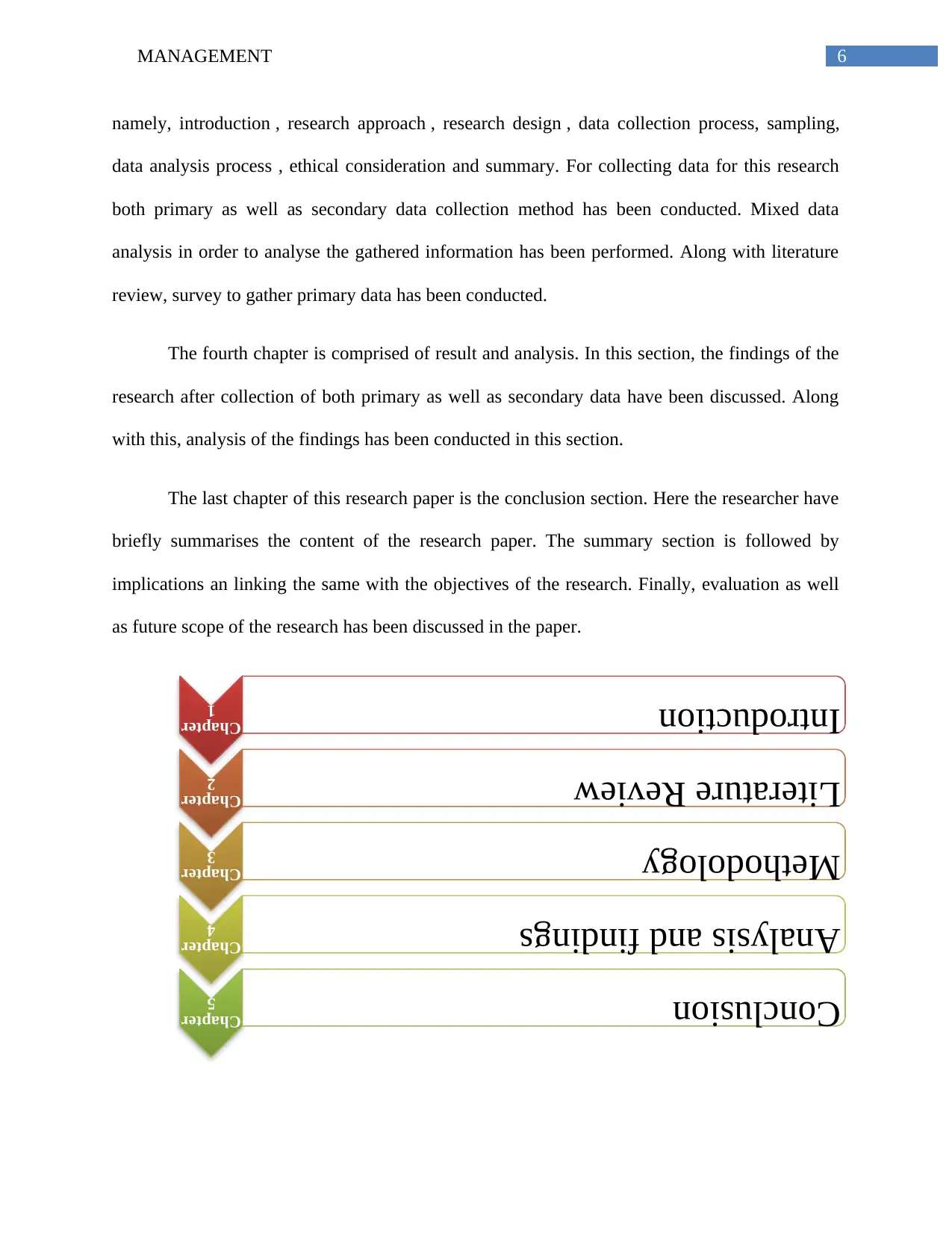
6MANAGEMENT
namely, introduction , research approach , research design , data collection process, sampling,
data analysis process , ethical consideration and summary. For collecting data for this research
both primary as well as secondary data collection method has been conducted. Mixed data
analysis in order to analyse the gathered information has been performed. Along with literature
review, survey to gather primary data has been conducted.
The fourth chapter is comprised of result and analysis. In this section, the findings of the
research after collection of both primary as well as secondary data have been discussed. Along
with this, analysis of the findings has been conducted in this section.
The last chapter of this research paper is the conclusion section. Here the researcher have
briefly summarises the content of the research paper. The summary section is followed by
implications an linking the same with the objectives of the research. Finally, evaluation as well
as future scope of the research has been discussed in the paper.
Chapter
1Introduction
Chapter
2Literature Review
Chapter
3Methodology
Chapter
4Analysis and findings
Chapter
5Conclusion
namely, introduction , research approach , research design , data collection process, sampling,
data analysis process , ethical consideration and summary. For collecting data for this research
both primary as well as secondary data collection method has been conducted. Mixed data
analysis in order to analyse the gathered information has been performed. Along with literature
review, survey to gather primary data has been conducted.
The fourth chapter is comprised of result and analysis. In this section, the findings of the
research after collection of both primary as well as secondary data have been discussed. Along
with this, analysis of the findings has been conducted in this section.
The last chapter of this research paper is the conclusion section. Here the researcher have
briefly summarises the content of the research paper. The summary section is followed by
implications an linking the same with the objectives of the research. Finally, evaluation as well
as future scope of the research has been discussed in the paper.
Chapter
1Introduction
Chapter
2Literature Review
Chapter
3Methodology
Chapter
4Analysis and findings
Chapter
5Conclusion
Paraphrase This Document
Need a fresh take? Get an instant paraphrase of this document with our AI Paraphraser
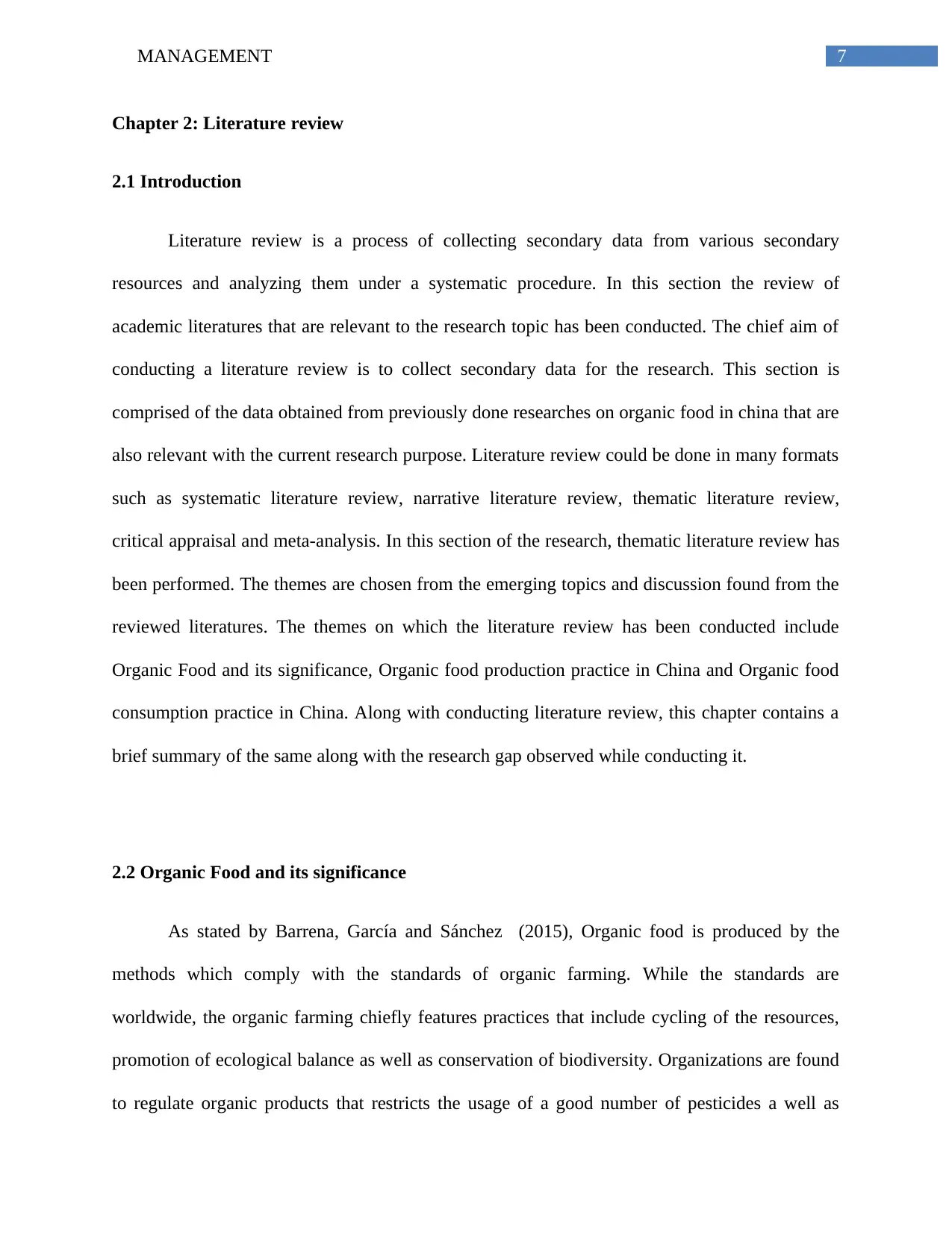
7MANAGEMENT
Chapter 2: Literature review
2.1 Introduction
Literature review is a process of collecting secondary data from various secondary
resources and analyzing them under a systematic procedure. In this section the review of
academic literatures that are relevant to the research topic has been conducted. The chief aim of
conducting a literature review is to collect secondary data for the research. This section is
comprised of the data obtained from previously done researches on organic food in china that are
also relevant with the current research purpose. Literature review could be done in many formats
such as systematic literature review, narrative literature review, thematic literature review,
critical appraisal and meta-analysis. In this section of the research, thematic literature review has
been performed. The themes are chosen from the emerging topics and discussion found from the
reviewed literatures. The themes on which the literature review has been conducted include
Organic Food and its significance, Organic food production practice in China and Organic food
consumption practice in China. Along with conducting literature review, this chapter contains a
brief summary of the same along with the research gap observed while conducting it.
2.2 Organic Food and its significance
As stated by Barrena, García and Sánchez (2015), Organic food is produced by the
methods which comply with the standards of organic farming. While the standards are
worldwide, the organic farming chiefly features practices that include cycling of the resources,
promotion of ecological balance as well as conservation of biodiversity. Organizations are found
to regulate organic products that restricts the usage of a good number of pesticides a well as
Chapter 2: Literature review
2.1 Introduction
Literature review is a process of collecting secondary data from various secondary
resources and analyzing them under a systematic procedure. In this section the review of
academic literatures that are relevant to the research topic has been conducted. The chief aim of
conducting a literature review is to collect secondary data for the research. This section is
comprised of the data obtained from previously done researches on organic food in china that are
also relevant with the current research purpose. Literature review could be done in many formats
such as systematic literature review, narrative literature review, thematic literature review,
critical appraisal and meta-analysis. In this section of the research, thematic literature review has
been performed. The themes are chosen from the emerging topics and discussion found from the
reviewed literatures. The themes on which the literature review has been conducted include
Organic Food and its significance, Organic food production practice in China and Organic food
consumption practice in China. Along with conducting literature review, this chapter contains a
brief summary of the same along with the research gap observed while conducting it.
2.2 Organic Food and its significance
As stated by Barrena, García and Sánchez (2015), Organic food is produced by the
methods which comply with the standards of organic farming. While the standards are
worldwide, the organic farming chiefly features practices that include cycling of the resources,
promotion of ecological balance as well as conservation of biodiversity. Organizations are found
to regulate organic products that restricts the usage of a good number of pesticides a well as
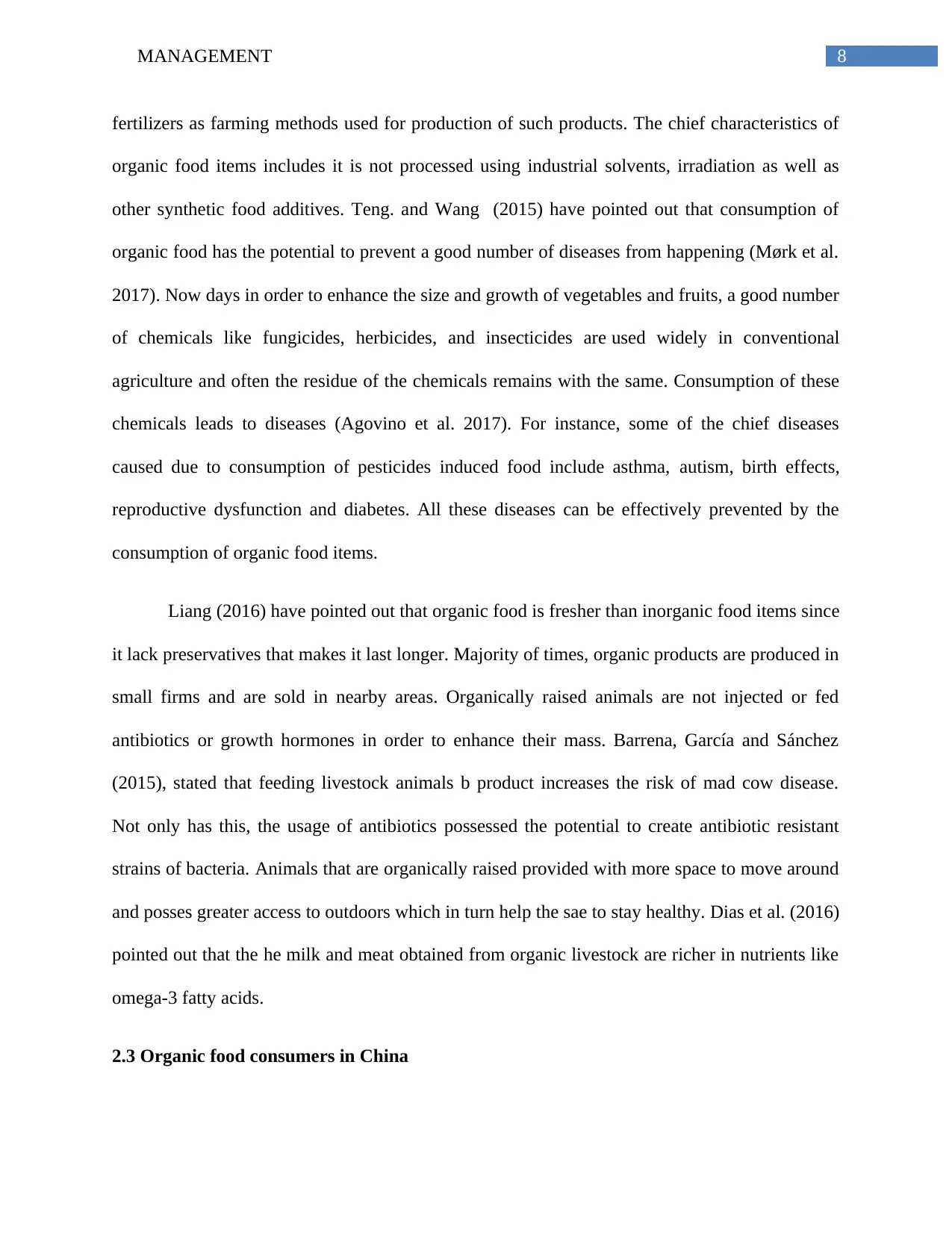
8MANAGEMENT
fertilizers as farming methods used for production of such products. The chief characteristics of
organic food items includes it is not processed using industrial solvents, irradiation as well as
other synthetic food additives. Teng. and Wang (2015) have pointed out that consumption of
organic food has the potential to prevent a good number of diseases from happening (Mørk et al.
2017). Now days in order to enhance the size and growth of vegetables and fruits, a good number
of chemicals like fungicides, herbicides, and insecticides are used widely in conventional
agriculture and often the residue of the chemicals remains with the same. Consumption of these
chemicals leads to diseases (Agovino et al. 2017). For instance, some of the chief diseases
caused due to consumption of pesticides induced food include asthma, autism, birth effects,
reproductive dysfunction and diabetes. All these diseases can be effectively prevented by the
consumption of organic food items.
Liang (2016) have pointed out that organic food is fresher than inorganic food items since
it lack preservatives that makes it last longer. Majority of times, organic products are produced in
small firms and are sold in nearby areas. Organically raised animals are not injected or fed
antibiotics or growth hormones in order to enhance their mass. Barrena, García and Sánchez
(2015), stated that feeding livestock animals b product increases the risk of mad cow disease.
Not only has this, the usage of antibiotics possessed the potential to create antibiotic resistant
strains of bacteria. Animals that are organically raised provided with more space to move around
and posses greater access to outdoors which in turn help the sae to stay healthy. Dias et al. (2016)
pointed out that the he milk and meat obtained from organic livestock are richer in nutrients like
omega-3 fatty acids.
2.3 Organic food consumers in China
fertilizers as farming methods used for production of such products. The chief characteristics of
organic food items includes it is not processed using industrial solvents, irradiation as well as
other synthetic food additives. Teng. and Wang (2015) have pointed out that consumption of
organic food has the potential to prevent a good number of diseases from happening (Mørk et al.
2017). Now days in order to enhance the size and growth of vegetables and fruits, a good number
of chemicals like fungicides, herbicides, and insecticides are used widely in conventional
agriculture and often the residue of the chemicals remains with the same. Consumption of these
chemicals leads to diseases (Agovino et al. 2017). For instance, some of the chief diseases
caused due to consumption of pesticides induced food include asthma, autism, birth effects,
reproductive dysfunction and diabetes. All these diseases can be effectively prevented by the
consumption of organic food items.
Liang (2016) have pointed out that organic food is fresher than inorganic food items since
it lack preservatives that makes it last longer. Majority of times, organic products are produced in
small firms and are sold in nearby areas. Organically raised animals are not injected or fed
antibiotics or growth hormones in order to enhance their mass. Barrena, García and Sánchez
(2015), stated that feeding livestock animals b product increases the risk of mad cow disease.
Not only has this, the usage of antibiotics possessed the potential to create antibiotic resistant
strains of bacteria. Animals that are organically raised provided with more space to move around
and posses greater access to outdoors which in turn help the sae to stay healthy. Dias et al. (2016)
pointed out that the he milk and meat obtained from organic livestock are richer in nutrients like
omega-3 fatty acids.
2.3 Organic food consumers in China
⊘ This is a preview!⊘
Do you want full access?
Subscribe today to unlock all pages.

Trusted by 1+ million students worldwide
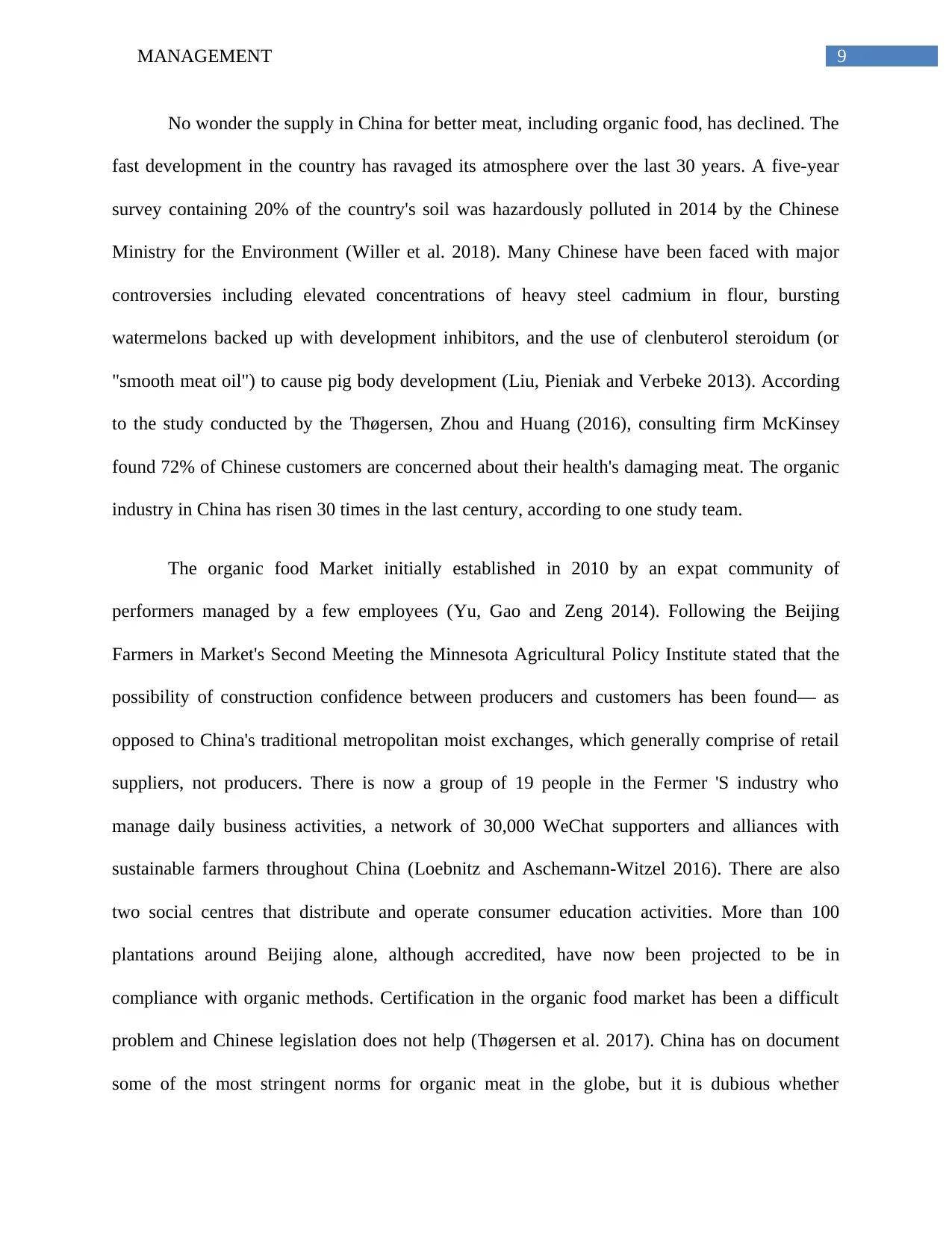
9MANAGEMENT
No wonder the supply in China for better meat, including organic food, has declined. The
fast development in the country has ravaged its atmosphere over the last 30 years. A five-year
survey containing 20% of the country's soil was hazardously polluted in 2014 by the Chinese
Ministry for the Environment (Willer et al. 2018). Many Chinese have been faced with major
controversies including elevated concentrations of heavy steel cadmium in flour, bursting
watermelons backed up with development inhibitors, and the use of clenbuterol steroidum (or
"smooth meat oil") to cause pig body development (Liu, Pieniak and Verbeke 2013). According
to the study conducted by the Thøgersen, Zhou and Huang (2016), consulting firm McKinsey
found 72% of Chinese customers are concerned about their health's damaging meat. The organic
industry in China has risen 30 times in the last century, according to one study team.
The organic food Market initially established in 2010 by an expat community of
performers managed by a few employees (Yu, Gao and Zeng 2014). Following the Beijing
Farmers in Market's Second Meeting the Minnesota Agricultural Policy Institute stated that the
possibility of construction confidence between producers and customers has been found— as
opposed to China's traditional metropolitan moist exchanges, which generally comprise of retail
suppliers, not producers. There is now a group of 19 people in the Fermer 'S industry who
manage daily business activities, a network of 30,000 WeChat supporters and alliances with
sustainable farmers throughout China (Loebnitz and Aschemann-Witzel 2016). There are also
two social centres that distribute and operate consumer education activities. More than 100
plantations around Beijing alone, although accredited, have now been projected to be in
compliance with organic methods. Certification in the organic food market has been a difficult
problem and Chinese legislation does not help (Thøgersen et al. 2017). China has on document
some of the most stringent norms for organic meat in the globe, but it is dubious whether
No wonder the supply in China for better meat, including organic food, has declined. The
fast development in the country has ravaged its atmosphere over the last 30 years. A five-year
survey containing 20% of the country's soil was hazardously polluted in 2014 by the Chinese
Ministry for the Environment (Willer et al. 2018). Many Chinese have been faced with major
controversies including elevated concentrations of heavy steel cadmium in flour, bursting
watermelons backed up with development inhibitors, and the use of clenbuterol steroidum (or
"smooth meat oil") to cause pig body development (Liu, Pieniak and Verbeke 2013). According
to the study conducted by the Thøgersen, Zhou and Huang (2016), consulting firm McKinsey
found 72% of Chinese customers are concerned about their health's damaging meat. The organic
industry in China has risen 30 times in the last century, according to one study team.
The organic food Market initially established in 2010 by an expat community of
performers managed by a few employees (Yu, Gao and Zeng 2014). Following the Beijing
Farmers in Market's Second Meeting the Minnesota Agricultural Policy Institute stated that the
possibility of construction confidence between producers and customers has been found— as
opposed to China's traditional metropolitan moist exchanges, which generally comprise of retail
suppliers, not producers. There is now a group of 19 people in the Fermer 'S industry who
manage daily business activities, a network of 30,000 WeChat supporters and alliances with
sustainable farmers throughout China (Loebnitz and Aschemann-Witzel 2016). There are also
two social centres that distribute and operate consumer education activities. More than 100
plantations around Beijing alone, although accredited, have now been projected to be in
compliance with organic methods. Certification in the organic food market has been a difficult
problem and Chinese legislation does not help (Thøgersen et al. 2017). China has on document
some of the most stringent norms for organic meat in the globe, but it is dubious whether
Paraphrase This Document
Need a fresh take? Get an instant paraphrase of this document with our AI Paraphraser
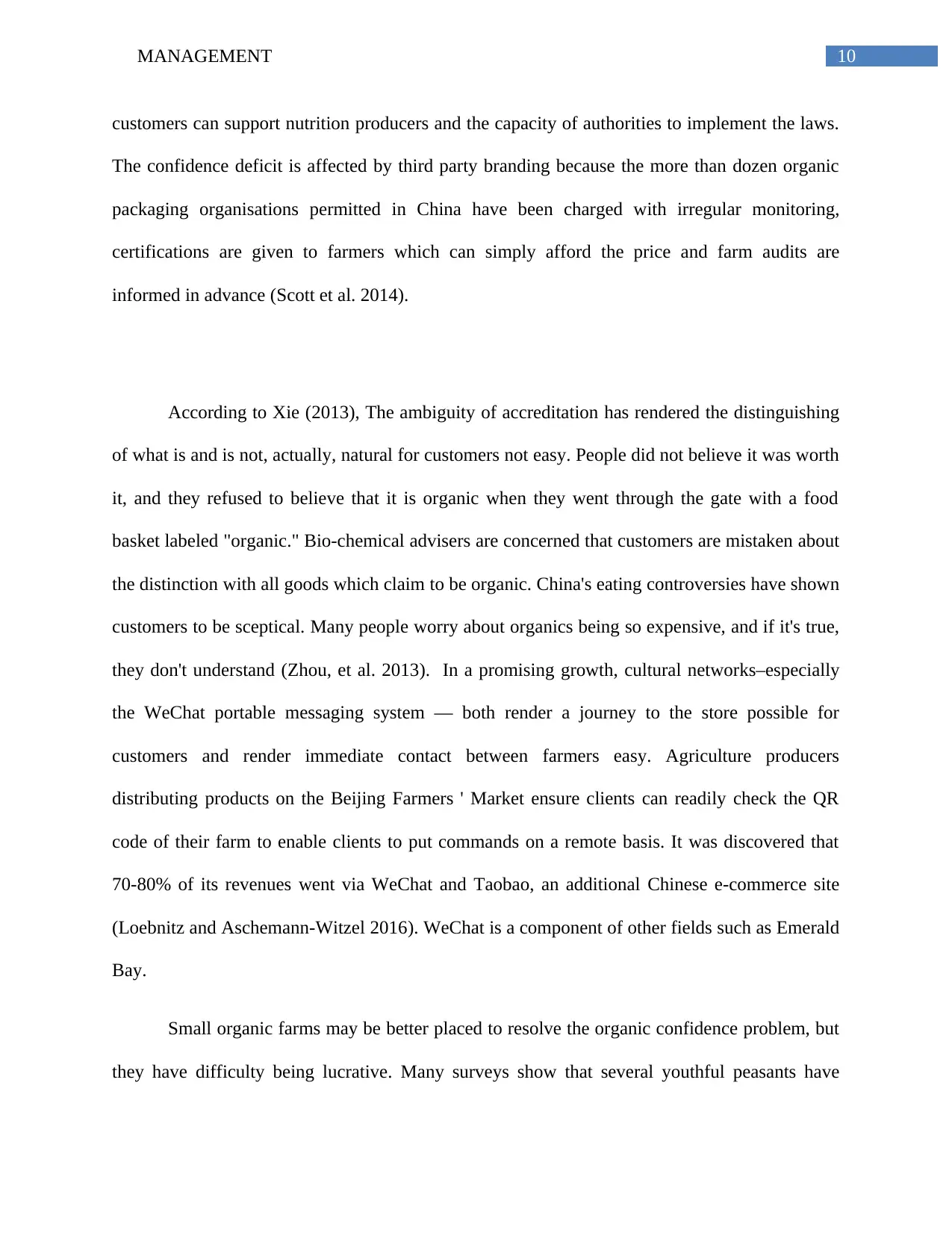
10MANAGEMENT
customers can support nutrition producers and the capacity of authorities to implement the laws.
The confidence deficit is affected by third party branding because the more than dozen organic
packaging organisations permitted in China have been charged with irregular monitoring,
certifications are given to farmers which can simply afford the price and farm audits are
informed in advance (Scott et al. 2014).
According to Xie (2013), The ambiguity of accreditation has rendered the distinguishing
of what is and is not, actually, natural for customers not easy. People did not believe it was worth
it, and they refused to believe that it is organic when they went through the gate with a food
basket labeled "organic." Bio-chemical advisers are concerned that customers are mistaken about
the distinction with all goods which claim to be organic. China's eating controversies have shown
customers to be sceptical. Many people worry about organics being so expensive, and if it's true,
they don't understand (Zhou, et al. 2013). In a promising growth, cultural networks–especially
the WeChat portable messaging system — both render a journey to the store possible for
customers and render immediate contact between farmers easy. Agriculture producers
distributing products on the Beijing Farmers ' Market ensure clients can readily check the QR
code of their farm to enable clients to put commands on a remote basis. It was discovered that
70-80% of its revenues went via WeChat and Taobao, an additional Chinese e-commerce site
(Loebnitz and Aschemann-Witzel 2016). WeChat is a component of other fields such as Emerald
Bay.
Small organic farms may be better placed to resolve the organic confidence problem, but
they have difficulty being lucrative. Many surveys show that several youthful peasants have
customers can support nutrition producers and the capacity of authorities to implement the laws.
The confidence deficit is affected by third party branding because the more than dozen organic
packaging organisations permitted in China have been charged with irregular monitoring,
certifications are given to farmers which can simply afford the price and farm audits are
informed in advance (Scott et al. 2014).
According to Xie (2013), The ambiguity of accreditation has rendered the distinguishing
of what is and is not, actually, natural for customers not easy. People did not believe it was worth
it, and they refused to believe that it is organic when they went through the gate with a food
basket labeled "organic." Bio-chemical advisers are concerned that customers are mistaken about
the distinction with all goods which claim to be organic. China's eating controversies have shown
customers to be sceptical. Many people worry about organics being so expensive, and if it's true,
they don't understand (Zhou, et al. 2013). In a promising growth, cultural networks–especially
the WeChat portable messaging system — both render a journey to the store possible for
customers and render immediate contact between farmers easy. Agriculture producers
distributing products on the Beijing Farmers ' Market ensure clients can readily check the QR
code of their farm to enable clients to put commands on a remote basis. It was discovered that
70-80% of its revenues went via WeChat and Taobao, an additional Chinese e-commerce site
(Loebnitz and Aschemann-Witzel 2016). WeChat is a component of other fields such as Emerald
Bay.
Small organic farms may be better placed to resolve the organic confidence problem, but
they have difficulty being lucrative. Many surveys show that several youthful peasants have
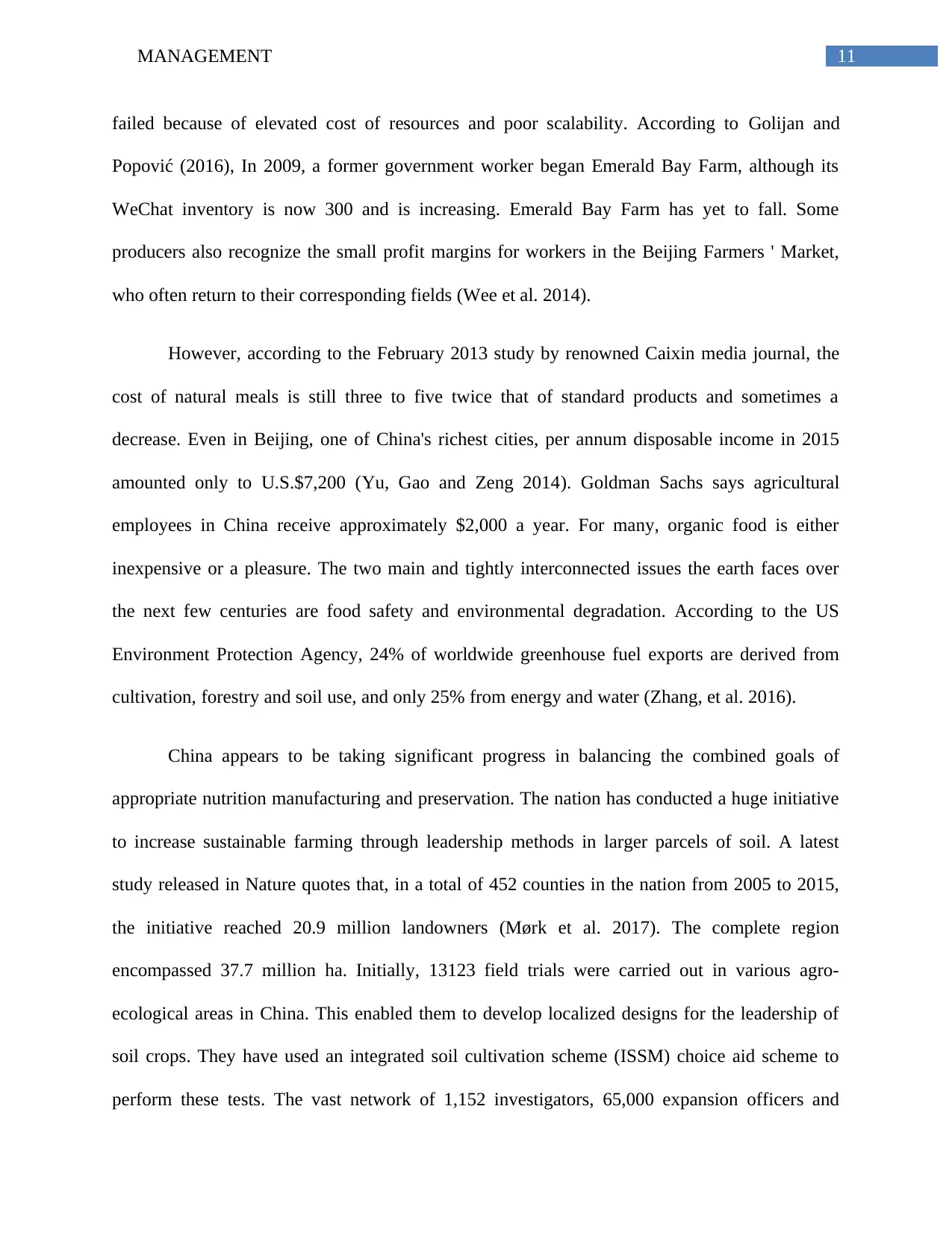
11MANAGEMENT
failed because of elevated cost of resources and poor scalability. According to Golijan and
Popović (2016), In 2009, a former government worker began Emerald Bay Farm, although its
WeChat inventory is now 300 and is increasing. Emerald Bay Farm has yet to fall. Some
producers also recognize the small profit margins for workers in the Beijing Farmers ' Market,
who often return to their corresponding fields (Wee et al. 2014).
However, according to the February 2013 study by renowned Caixin media journal, the
cost of natural meals is still three to five twice that of standard products and sometimes a
decrease. Even in Beijing, one of China's richest cities, per annum disposable income in 2015
amounted only to U.S.$7,200 (Yu, Gao and Zeng 2014). Goldman Sachs says agricultural
employees in China receive approximately $2,000 a year. For many, organic food is either
inexpensive or a pleasure. The two main and tightly interconnected issues the earth faces over
the next few centuries are food safety and environmental degradation. According to the US
Environment Protection Agency, 24% of worldwide greenhouse fuel exports are derived from
cultivation, forestry and soil use, and only 25% from energy and water (Zhang, et al. 2016).
China appears to be taking significant progress in balancing the combined goals of
appropriate nutrition manufacturing and preservation. The nation has conducted a huge initiative
to increase sustainable farming through leadership methods in larger parcels of soil. A latest
study released in Nature quotes that, in a total of 452 counties in the nation from 2005 to 2015,
the initiative reached 20.9 million landowners (Mørk et al. 2017). The complete region
encompassed 37.7 million ha. Initially, 13123 field trials were carried out in various agro-
ecological areas in China. This enabled them to develop localized designs for the leadership of
soil crops. They have used an integrated soil cultivation scheme (ISSM) choice aid scheme to
perform these tests. The vast network of 1,152 investigators, 65,000 expansion officers and
failed because of elevated cost of resources and poor scalability. According to Golijan and
Popović (2016), In 2009, a former government worker began Emerald Bay Farm, although its
WeChat inventory is now 300 and is increasing. Emerald Bay Farm has yet to fall. Some
producers also recognize the small profit margins for workers in the Beijing Farmers ' Market,
who often return to their corresponding fields (Wee et al. 2014).
However, according to the February 2013 study by renowned Caixin media journal, the
cost of natural meals is still three to five twice that of standard products and sometimes a
decrease. Even in Beijing, one of China's richest cities, per annum disposable income in 2015
amounted only to U.S.$7,200 (Yu, Gao and Zeng 2014). Goldman Sachs says agricultural
employees in China receive approximately $2,000 a year. For many, organic food is either
inexpensive or a pleasure. The two main and tightly interconnected issues the earth faces over
the next few centuries are food safety and environmental degradation. According to the US
Environment Protection Agency, 24% of worldwide greenhouse fuel exports are derived from
cultivation, forestry and soil use, and only 25% from energy and water (Zhang, et al. 2016).
China appears to be taking significant progress in balancing the combined goals of
appropriate nutrition manufacturing and preservation. The nation has conducted a huge initiative
to increase sustainable farming through leadership methods in larger parcels of soil. A latest
study released in Nature quotes that, in a total of 452 counties in the nation from 2005 to 2015,
the initiative reached 20.9 million landowners (Mørk et al. 2017). The complete region
encompassed 37.7 million ha. Initially, 13123 field trials were carried out in various agro-
ecological areas in China. This enabled them to develop localized designs for the leadership of
soil crops. They have used an integrated soil cultivation scheme (ISSM) choice aid scheme to
perform these tests. The vast network of 1,152 investigators, 65,000 expansion officers and
⊘ This is a preview!⊘
Do you want full access?
Subscribe today to unlock all pages.

Trusted by 1+ million students worldwide
1 out of 24
Related Documents
Your All-in-One AI-Powered Toolkit for Academic Success.
+13062052269
info@desklib.com
Available 24*7 on WhatsApp / Email
![[object Object]](/_next/static/media/star-bottom.7253800d.svg)
Unlock your academic potential
Copyright © 2020–2025 A2Z Services. All Rights Reserved. Developed and managed by ZUCOL.





